ESP SKODA ROOMSTER 2009 1.G Owner's Guide
[x] Cancel search | Manufacturer: SKODA, Model Year: 2009, Model line: ROOMSTER, Model: SKODA ROOMSTER 2009 1.GPages: 263, PDF Size: 32.25 MB
Page 118 of 263
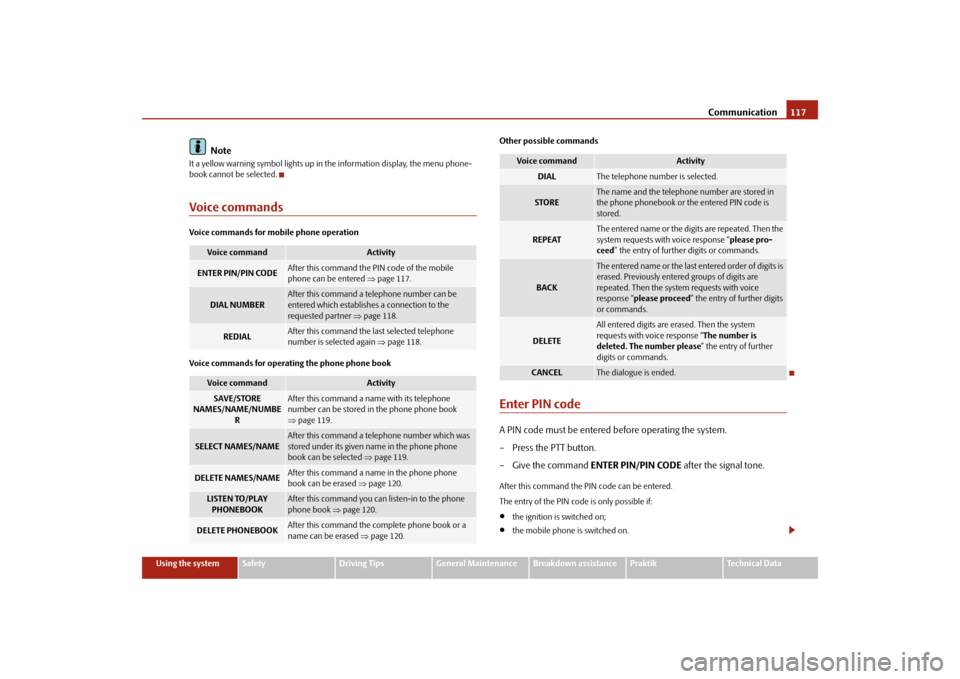
Communication117
Using the system
Safety
Driving Tips
General Maintenance
Breakdown assistance
Praktik
Technical Data
Note
It a yellow warning symbol lights up in the information display, the menu phone-
book cannot be selected.Voice commandsVoice commands for mobile phone operation
Voice commands for operating the phone phone bookOther possible commands
Enter PIN codeA PIN code must be entered before operating the system.
– Press the PTT button.
– Give the command ENTER PIN/PIN CODE after the signal tone.After this command the PIN code can be entered.
The entry of the PIN code is only possible if:•
the ignition is switched on;
•
the mobile phone is switched on.
Voice command
Activity
ENTER PIN/PIN CODE
After this command the PIN code of the mobile
phone can be entered ⇒page 117.
DIAL NUMBER
After this command a telephone number can be
entered which establishes a connection to the
requested partner ⇒page 118.
REDIAL
After this command the last selected telephone
number is selected again ⇒page 118.
Voice command
Activity
SAVE/STORE
NAMES/NAME/NUMBE
R
After this command a name with its telephone
number can be stored in the phone phone book
⇒page 119.
SELECT NAMES/NAME
After this command a telephone number which was
stored under its given name in the phone phone
book can be selected ⇒page 119.
DELETE NAMES/NAME
After this command a name in the phone phone
book can be erased ⇒page 120.
LISTEN TO/PLAY
PHONEBOOK
After this command you can listen-in to the phone
phone book ⇒page 120.
DELETE PHONEBOOK
After this command the complete phone book or a
name can be erased ⇒page 120.
Voice command
Activity
DIAL
The telephone number is selected.
STORE
The name and the telephone number are stored in
the phone phonebook or the entered PIN code is
stored.
REPEAT
The entered name or the digits are repeated. Then the
system requests with voice response “please pro-
ceed” the entry of further digits or commands.
BACK
The entered name or the last entered order of digits is
erased. Previously entered groups of digits are
repeated. Then the system requests with voice
response “please proceed” the entry of further digits
or commands.
DELETE
All entered digits are erased. Then the system
requests with voice response “The number is
deleted. The number please” the entry of further
digits or commands.
CANCEL
The dialogue is ended.
s29g.4.book Page 117 Wednesday, June 17, 2009 9:54 AM
Page 121 of 263
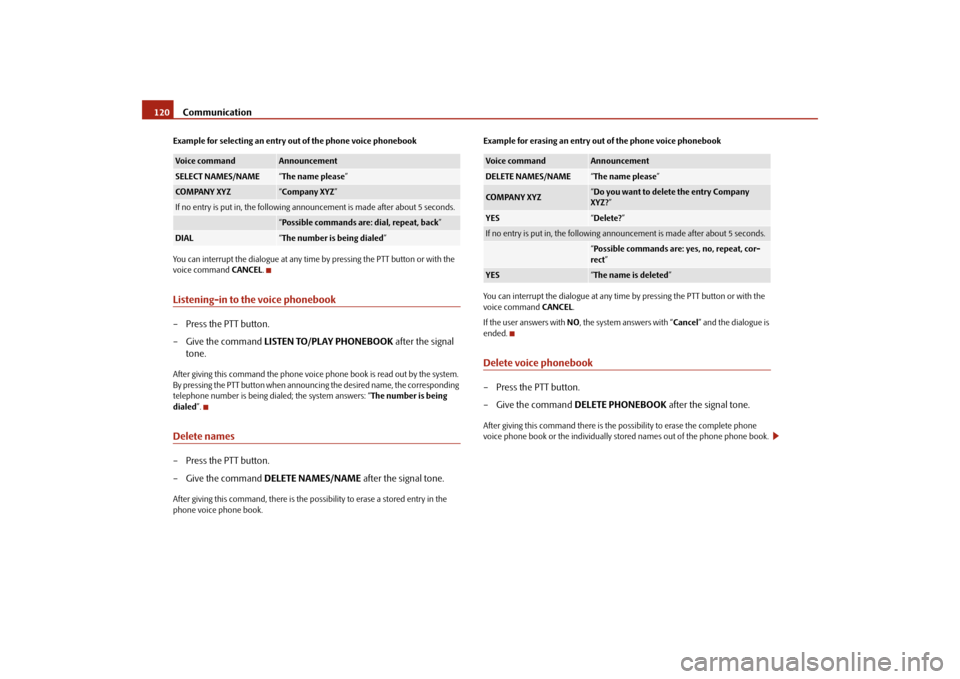
Communication 120Example for selecting an entry out of the phone voice phonebook
You can interrupt the dialogue at any time by pressing the PTT button or with the
voice command CANCEL.Listening-in to the voice phonebook– Press the PTT button.
– Give the command LISTEN TO/PLAY PHONEBOOK after the signal
tone.After giving this command the phone voice phone book is read out by the system.
By pressing the PTT button when announcing the desired name, the corresponding
telephone number is being dialed; the system answers: “The number is being
dialed”.Delete names– Press the PTT button.
– Give the command DELETE NAMES/NAME after the signal tone.After giving this command, there is the possibility to erase a stored entry in the
phone voice phone book.Example for erasing an entry out of the phone voice phonebook
You can interrupt the dialogue at any time by pressing the PTT button or with the
voice command CANCEL.
If the user answers with NO, the system answers with “Cancel” and the dialogue is
ended.
Delete voice phonebook– Press the PTT button.
– Give the command DELETE PHONEBOOK after the signal tone.After giving this command there is the possibility to erase the complete phone
voice phone book or the individually stored names out of the phone phone book.
Voice command
Announcement
SELECT NAMES/NAME
“The name please”
COMPANY XYZ
“Company XYZ”
If no entry is put in, the following announcement is made after about 5 seconds.
“Possible commands are: dial, repeat, back”
DIAL
“The number is being dialed”
Voice command
Announcement
DELETE NAMES/NAME
“The name please”
COMPANY XYZ
“Do you want to delete the entry Company
XYZ?”
YES
“Delete?”
If no entry is put in, the following announcement is made after about 5 seconds.
“Possible commands are: yes, no, repeat, cor-
rect”
YES
“The name is deleted”
s29g.4.book Page 120 Wednesday, June 17, 2009 9:54 AM
Page 123 of 263
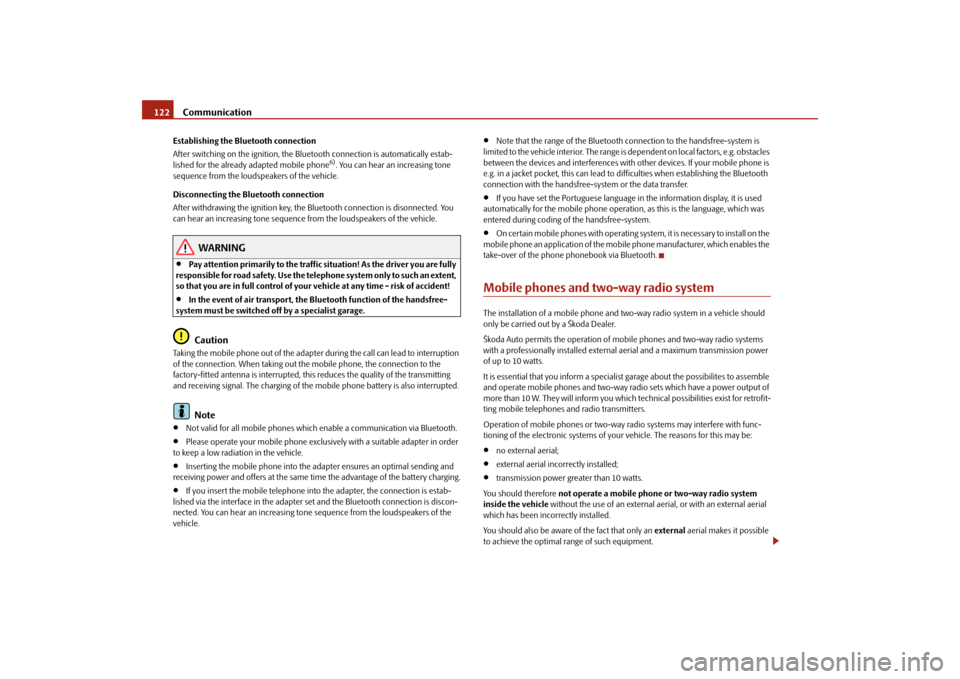
Communication 122Establishing the Bluetooth connection
After switching on the ignition, the Bluetooth connection is automatically estab-
lished for the already adapted mobile phone
6). You can hear an increasing tone
sequence from the loudspeakers of the vehicle.
Disconnecting the Bluetooth connection
After withdrawing the ignition key, the Bluetooth connection is disonnected. You
can hear an increasing tone sequence from the loudspeakers of the vehicle.
WARNING
•
Pay attention primarily to the traffic situation! As the driver you are fully
responsible for road safety. Use the telephone system only to such an extent,
so that you are in full control of your vehicle at any time - risk of accident!
•
In the event of air transport, the Bluetooth function of the handsfree-
system must be switched off by a specialist garage.Caution
Taking the mobile phone out of the adapter during the call can lead to interruption
of the connection. When taking out the mobile phone, the connection to the
factory-fitted antenna is interrupted, this reduces the quality of the transmitting
and receiving signal. The charging of the mobile phone battery is also interrupted.
Note
•
Not valid for all mobile phones which enable a communication via Bluetooth.
•
Please operate your mobile phone exclusively with a suitable adapter in order
to keep a low radiation in the vehicle.
•
Inserting the mobile phone into the adapter ensures an optimal sending and
receiving power and offers at the same time the advantage of the battery charging.
•
If you insert the mobile telephone into the adapter, the connection is estab-
lished via the interface in the adapter set and the Bluetooth connection is discon-
nected. You can hear an increasing tone sequence from the loudspeakers of the
vehicle.
•
Note that the range of the Bluetooth connection to the handsfree-system is
limited to the vehicle interior. The range is dependent on local factors, e.g. obstacles
between the devices and interferences with other devices. If your mobile phone is
e.g. in a jacket pocket, this can lead to difficulties when establishing the Bluetooth
connection with the handsfree-system or the data transfer.
•
If you have set the Portuguese language in the information display, it is used
automatically for the mobile phone operation, as this is the language, which was
entered during coding of the handsfree-system.
•
On certain mobile phones with operating system, it is necessary to install on the
mobile phone an application of the mobile phone manufacturer, which enables the
take-over of the phone phonebook via Bluetooth.
Mobile phones and two-way radio systemThe installation of a mobile phone and two-way radio system in a vehicle should
only be carried out by a Škoda Dealer.
Škoda Auto permits the operation of mobile phones and two-way radio systems
with a professionally installed external aerial and a maximum transmission power
of up to 10 watts.
It is essential that you inform a specialist garage about the possibilites to assemble
and operate mobile phones and two-way radio sets which have a power output of
more than 10 W. They will inform you which technical possibilities exist for retrofit-
ting mobile telephones and radio transmitters.
Operation of mobile phones or two-way radio systems may interfere with func-
tioning of the electronic systems of your vehicle. The reasons for this may be:•
no external aerial;
•
external aerial incorrectly installed;
•
transmission power greater than 10 watts.
You should therefore not operate a mobile phone or two-way radio system
inside the vehicle without the use of an external aerial, or with an external aerial
which has been incorrectly installed.
You should also be aware of the fact that only an external aerial makes it possible
to achieve the optimal range of such equipment.
s29g.4.book Page 122 Wednesday, June 17, 2009 9:54 AM
Page 124 of 263
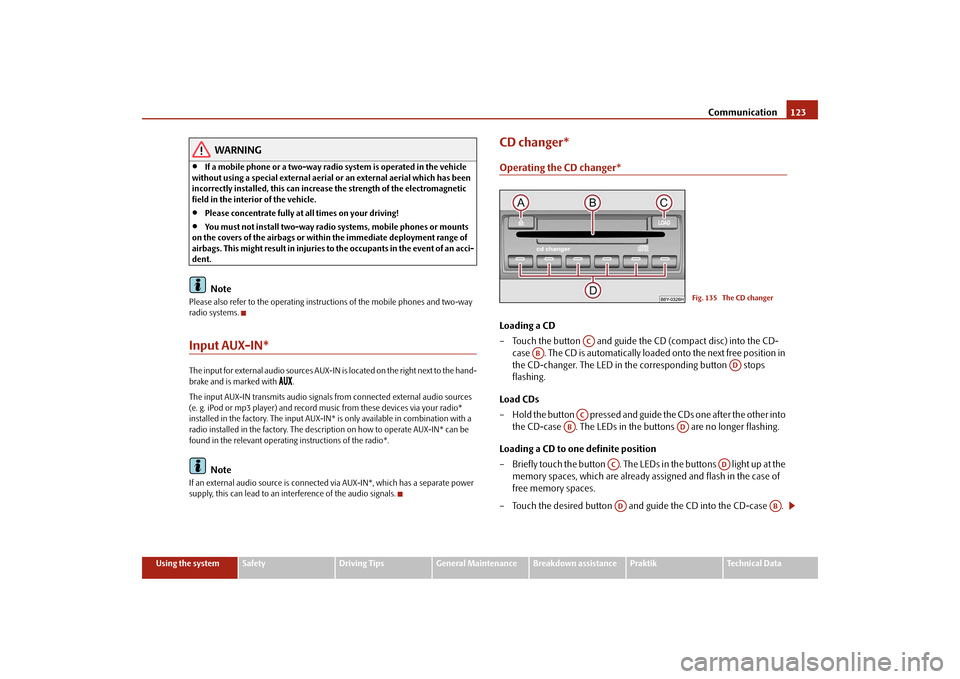
Communication123
Using the system
Safety
Driving Tips
General Maintenance
Breakdown assistance
Praktik
Technical Data
WARNING
•
If a mobile phone or a two-way radio system is operated in the vehicle
without using a special external aerial or an external aerial which has been
incorrectly installed, this can increase the strength of the electromagnetic
field in the interior of the vehicle.
•
Please concentrate fully at all times on your driving!
•
You must not install two-way radio systems, mobile phones or mounts
on the covers of the airbags or within the immediate deployment range of
airbags. This might result in injuries to the occupants in the event of an acci-
dent.Note
Please also refer to the operating instructions of the mobile phones and two-way
radio systems.Input AUX-IN*The input for external audio sources AUX-IN is located on the right next to the hand-
brake and is marked with
.
The input AUX-IN transmits audio signals from connected external audio sources
(e. g. iPod or mp3 player) and record music from these devices via your radio*
installed in the factory. The input AUX-IN* is only available in combination with a
radio installed in the factory. The description on how to operate AUX-IN* can be
found in the relevant operating instructions of the radio*.
Note
If an external audio source is connected via AUX-IN*, which has a separate power
supply, this can lead to an interference of the audio signals.
CD changer*Operating the CD changer*Loading a CD
– Touch the button and guide the CD (compact disc) into the CD-
case . The CD is automatically loaded onto the next free position in
the CD-changer. The LED in the corresponding button stops
flashing.
Load CDs
– Hold the button pressed and guide the CDs one after the other into
the CD-case . The LEDs in the buttons are no longer flashing.
Loading a CD to one definite position
– Briefly touch the button . The LEDs in the buttons light up at the
memory spaces, which are already assigned and flash in the case of
free memory spaces.
– Touch the desired button and guide the CD into the CD-case .
Fig. 135 The CD changer
AC
AB
AD
AC
AB
AD
AC
AD
AD
AB
s29g.4.book Page 123 Wednesday, June 17, 2009 9:54 AM
Page 125 of 263
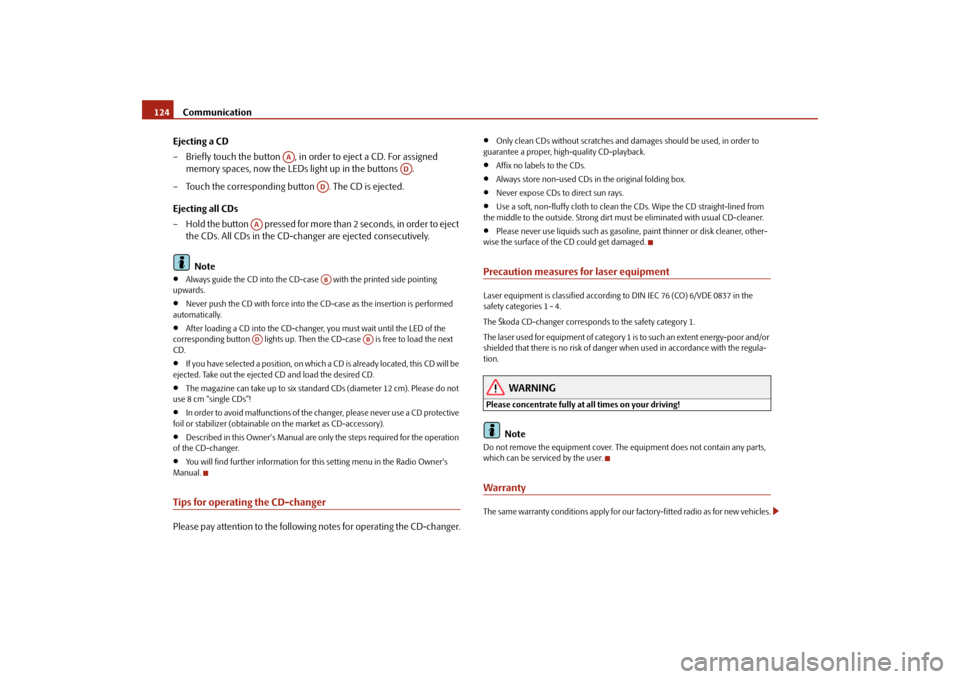
Communication 124
Ejecting a CD
– Briefly touch the button , in order to eject a CD. For assigned
memory spaces, now the LEDs light up in the buttons .
– Touch the corresponding button . The CD is ejected.
Ejecting all CDs
– Hold the button pressed for more than 2 seconds, in order to eject
the CDs. All CDs in the CD-changer are ejected consecutively.
Note•
Always guide the CD into the CD-case with the printed side pointing
upwards.
•
Never push the CD with force into the CD-case as the insertion is performed
automatically.
•
After loading a CD into the CD-changer, you must wait until the LED of the
corresponding button lights up. Then the CD-case is free to load the next
CD.
•
If you have selected a position, on which a CD is already located, this CD will be
ejected. Take out the ejected CD and load the desired CD.
•
The magazine can take up to six standard CDs (diameter 12 cm). Please do not
use 8 cm “single CDs”!
•
In order to avoid malfunctions of the changer, please never use a CD protective
foil or stabilizer (obtainable on the market as CD-accessory).
•
Described in this Owner's Manual are only the steps required for the operation
of the CD-changer.
•
You will find further information for this setting menu in the Radio Owner's
Manual.
Tips for operating the CD-changerPlease pay attention to the following notes for operating the CD-changer.
•
Only clean CDs without scratches and damages should be used, in order to
guarantee a proper, high-quality CD-playback.
•
Affix no labels to the CDs.
•
Always store non-used CDs in the original folding box.
•
Never expose CDs to direct sun rays.
•
Use a soft, non-fluffy cloth to clean the CDs. Wipe the CD straight-lined from
the middle to the outside. Strong dirt must be eliminated with usual CD-cleaner.
•
Please never use liquids such as gasoline, paint thinner or disk cleaner, other-
wise the surface of the CD could get damaged.
Precaution measures for laser equipmentLaser equipment is classified according to DIN IEC 76 (CO) 6/VDE 0837 in the
safety categories 1 - 4.
The Škoda CD-changer corresponds to the safety category 1.
The laser used for equipment of category 1 is to such an extent energy-poor and/or
shielded that there is no risk of danger when used in accordance with the regula-
tion.
WARNING
Please concentrate fully at all times on your driving!
Note
Do not remove the equipment cover. The equipment does not contain any parts,
which can be serviced by the user.WarrantyThe same warranty conditions apply for our factory-fitted radio as for new vehicles.
AA
AD
AD
AA
AB
AD
AB
s29g.4.book Page 124 Wednesday, June 17, 2009 9:54 AM
Page 129 of 263
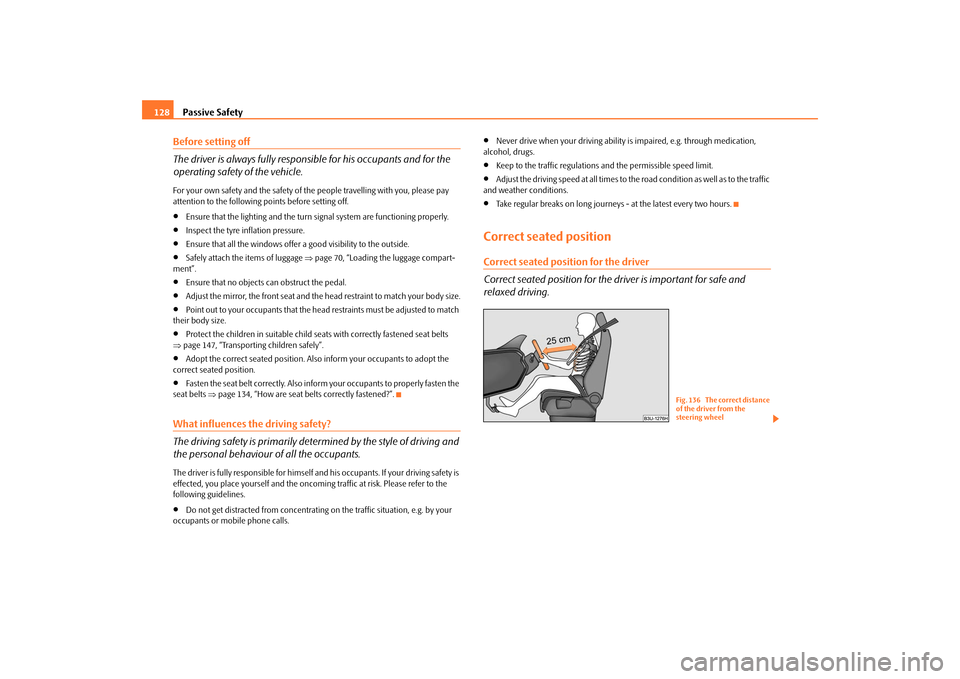
Passive Safety 128Before setting off
The driver is always fully responsible for his occupants and for the
operating safety of the vehicle.For your own safety and the safety of the people travelling with you, please pay
attention to the following points before setting off.•
Ensure that the lighting and the turn signal system are functioning properly.
•
Inspect the tyre inflation pressure.
•
Ensure that all the windows offer a good visibility to the outside.
•
Safely attach the items of luggage ⇒page 70, “Loading the luggage compart-
ment”.
•
Ensure that no objects can obstruct the pedal.
•
Adjust the mirror, the front seat and the head restraint to match your body size.
•
Point out to your occupants that the head restraints must be adjusted to match
their body size.
•
Protect the children in suitable child seats with correctly fastened seat belts
⇒page 147, “Transporting children safely”.
•
Adopt the correct seated position. Also inform your occupants to adopt the
correct seated position.
•
Fasten the seat belt correctly. Also inform your occupants to properly fasten the
seat belts ⇒page 134, “How are seat belts correctly fastened?”.
What influences the driving safety?
The driving safety is primarily determined by the style of driving and
the personal behaviour of all the occupants.The driver is fully responsible for himself and his occupants. If your driving safety is
effected, you place yourself and the oncoming traffic at risk. Please refer to the
following guidelines.•
Do not get distracted from concentrating on the traffic situation, e.g. by your
occupants or mobile phone calls.
•
Never drive when your driving ability is impaired, e.g. through medication,
alcohol, drugs.
•
Keep to the traffic regulations and the permissible speed limit.
•
Adjust the driving speed at all times to the road condition as well as to the traffic
and weather conditions.
•
Take regular breaks on long journeys - at the latest every two hours.
Correct seated positionCorrect seated position for the driver
Correct seated position for the driver is important for safe and
relaxed driving.
Fig. 136 The correct distance
of the driver from the
steering wheel
s29g.4.book Page 128 Wednesday, June 17, 2009 9:54 AM
Page 131 of 263
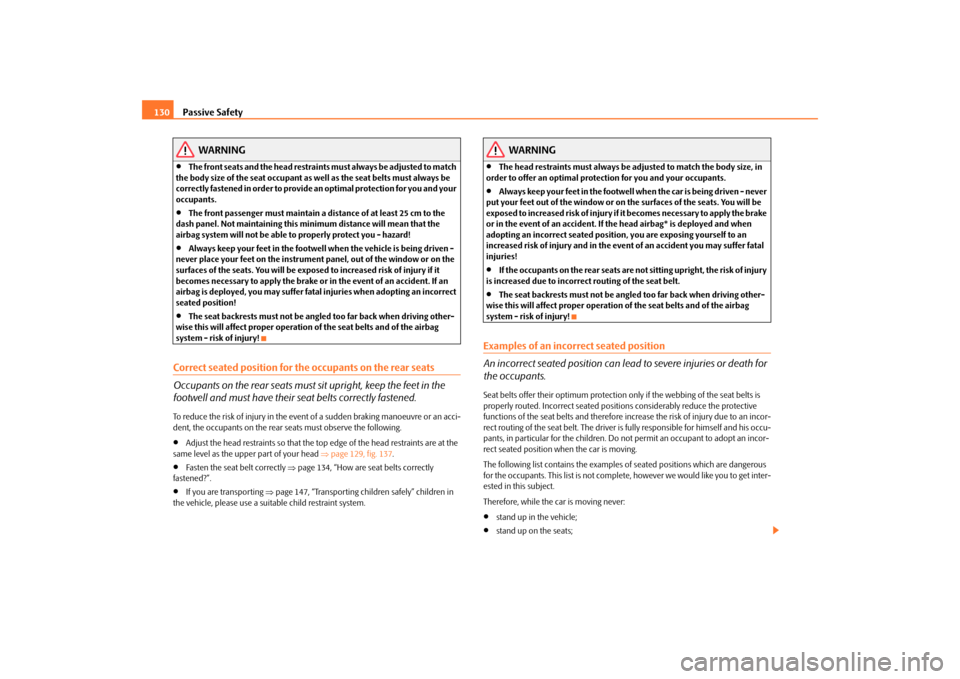
Passive Safety 130
WARNING
•
The front seats and the head restraints must always be adjusted to match
the body size of the seat occupant as well as the seat belts must always be
correctly fastened in order to provide an optimal protection for you and your
occupants.
•
The front passenger must maintain a distance of at least 25 cm to the
dash panel. Not maintaining this minimum distance will mean that the
airbag system will not be able to properly protect you - hazard!
•
Always keep your feet in the footwell when the vehicle is being driven -
never place your feet on the instrument panel, out of the window or on the
surfaces of the seats. You will be exposed to increased risk of injury if it
becomes necessary to apply the brake or in the event of an accident. If an
airbag is deployed, you may suffer fatal injuries when adopting an incorrect
seated position!
•
The seat backrests must not be angled too far back when driving other-
wise this will affect proper operation of the seat belts and of the airbag
system - risk of injury!
Correct seated position for the occupants on the rear seats
Occupants on the rear seats must sit upright, keep the feet in the
footwell and must have their seat belts correctly fastened.To reduce the risk of injury in the event of a sudden braking manoeuvre or an acci-
dent, the occupants on the rear seats must observe the following.•
Adjust the head restraints so that the top edge of the head restraints are at the
same level as the upper part of your head ⇒page 129, fig. 137.
•
Fasten the seat belt correctly ⇒page 134, “How are seat belts correctly
fastened?”.
•
If you are transporting ⇒page 147, “Transporting children safely” children in
the vehicle, please use a suitable child restraint system.
WARNING
•
The head restraints must always be adjusted to match the body size, in
order to offer an optimal protection for you and your occupants.
•
Always keep your feet in the footwell when the car is being driven - never
put your feet out of the window or on the surfaces of the seats. You will be
exposed to increased risk of injury if it becomes necessary to apply the brake
or in the event of an accident. If the head airbag* is deployed and when
adopting an incorrect seated position, you are exposing yourself to an
increased risk of injury and in the event of an accident you may suffer fatal
injuries!
•
If the occupants on the rear seats are not sitting upright, the risk of injury
is increased due to incorrect routing of the seat belt.
•
The seat backrests must not be angled too far back when driving other-
wise this will affect proper operation of the seat belts and of the airbag
system - risk of injury!
Examples of an incorrect seated position
An incorrect seated position can lead to severe injuries or death for
the occupants.Seat belts offer their optimum protection only if the webbing of the seat belts is
properly routed. Incorrect seated positions considerably reduce the protective
functions of the seat belts and therefore increase the risk of injury due to an incor-
rect routing of the seat belt. The driver is fully responsible for himself and his occu-
pants, in particular for the children. Do not permit an occupant to adopt an incor-
rect seated position when the car is moving.
The following list contains the examples of seated positions which are dangerous
for the occupants. This list is not complete, however we would like you to get inter-
ested in this subject.
Therefore, while the car is moving never:•
stand up in the vehicle;
•
stand up on the seats;
s29g.4.book Page 130 Wednesday, June 17, 2009 9:54 AM
Page 137 of 263
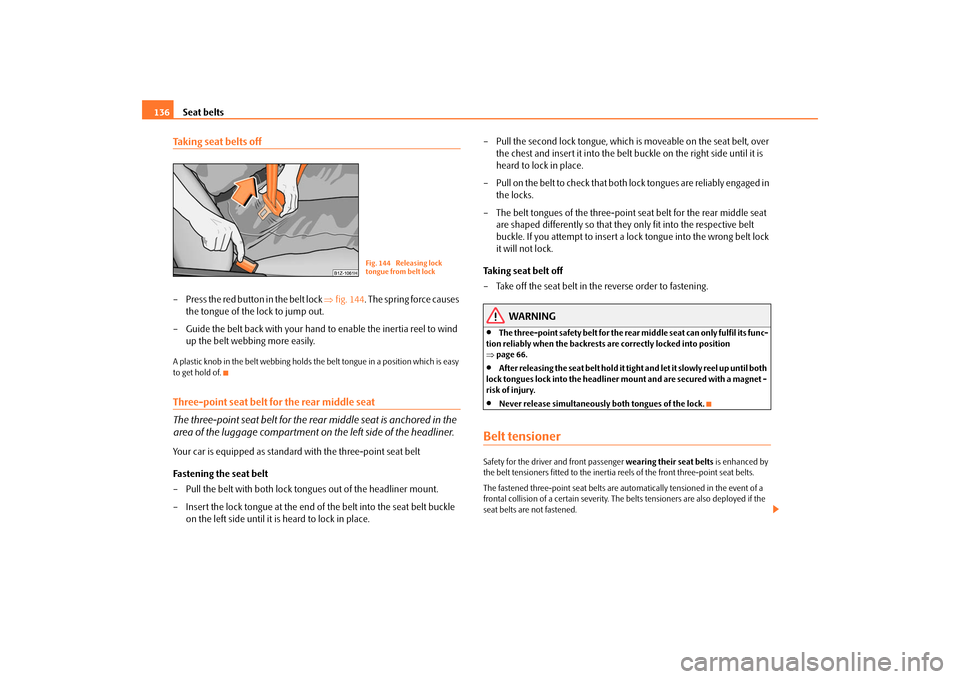
Seat belts 136Taking seat belts off– Press the red button in the belt lock ⇒fig. 144. The spring force causes
the tongue of the lock to jump out.
– Guide the belt back with your hand to enable the inertia reel to wind
up the belt webbing more easily.A plastic knob in the belt webbing holds the belt tongue in a position which is easy
to get hold of.Three-point seat belt for the rear middle seat
The three-point seat belt for the rear middle seat is anchored in the
area of the luggage compartment on the left side of the headliner.Your car is equipped as standard with the three-point seat belt
Fastening the seat belt
– Pull the belt with both lock tongues out of the headliner mount.
– Insert the lock tongue at the end of the belt into the seat belt buckle
on the left side until it is heard to lock in place.– Pull the second lock tongue, which is moveable on the seat belt, over
the chest and insert it into the belt buckle on the right side until it is
heard to lock in place.
– Pull on the belt to check that both lock tongues are reliably engaged in
the locks.
– The belt tongues of the three-point seat belt for the rear middle seat
are shaped differently so that they only fit into the respective belt
buckle. If you attempt to insert a lock tongue into the wrong belt lock
it will not lock.
Taking seat belt off
– Take off the seat belt in the reverse order to fastening.
WARNING
•
The three-point safety belt for the rear middle seat can only fulfil its func-
tion reliably when the backrests are correctly locked into position
⇒page 66.
•
After releasing the seat belt hold it tight and let it slowly reel up until both
lock tongues lock into the headliner mount and are secured with a magnet -
risk of injury.
•
Never release simultaneously both tongues of the lock.
Belt tensionerSafety for the driver and front passenger wearing their seat belts is enhanced by
the belt tensioners fitted to the inertia reels of the front three-point seat belts.
The fastened three-point seat belts are automatically tensioned in the event of a
frontal collision of a certain severity. The belts tensioners are also deployed if the
seat belts are not fastened.
Fig. 144 Releasing lock
tongue from belt lock
s29g.4.book Page 136 Wednesday, June 17, 2009 9:54 AM
Page 138 of 263
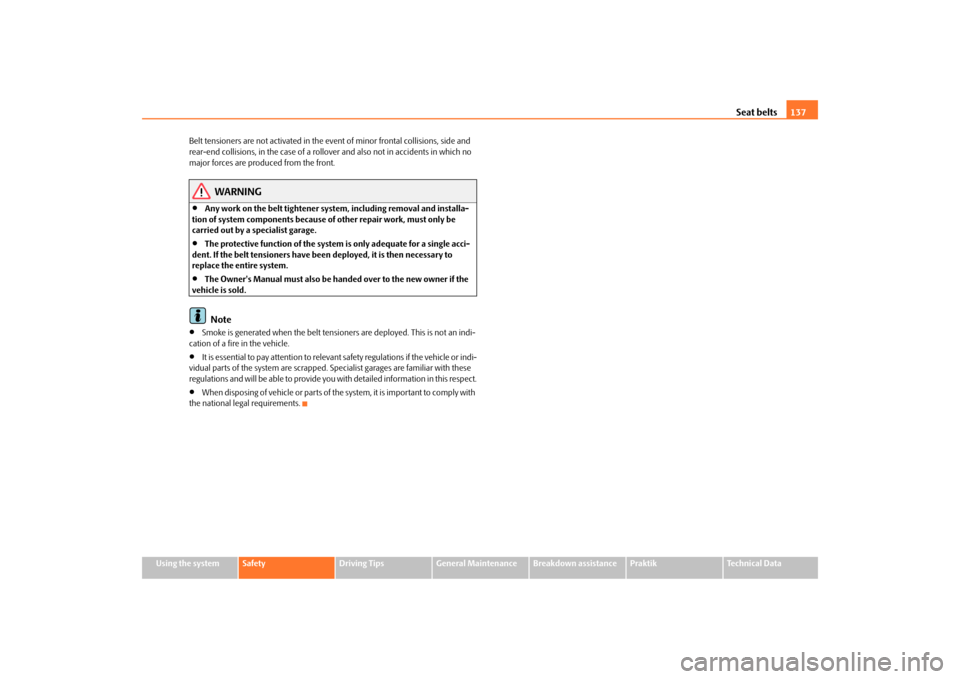
Seat belts137
Using the system
Safety
Driving Tips
General Maintenance
Breakdown assistance
Praktik
Technical Data Belt tensioners are not activated in the event of minor frontal collisions, side and
rear-end collisions, in the case of a rollover and also not in accidents in which no
major forces are produced from the front.
WARNING
•
Any work on the belt tightener system, including removal and installa-
tion of system components because of other repair work, must only be
carried out by a specialist garage.
•
The protective function of the system is only adequate for a single acci-
dent. If the belt tensioners have been deployed, it is then necessary to
replace the entire system.
•
The Owner's Manual must also be handed over to the new owner if the
vehicle is sold.Note
•
Smoke is generated when the belt tensioners are deployed. This is not an indi-
cation of a fire in the vehicle.
•
It is essential to pay attention to relevant safety regulations if the vehicle or indi-
vidual parts of the system are scrapped. Specialist garages are familiar with these
regulations and will be able to provide you with detailed information in this respect.
•
When disposing of vehicle or parts of the system, it is important to comply with
the national legal requirements.
s29g.4.book Page 137 Wednesday, June 17, 2009 9:54 AM
Page 146 of 263
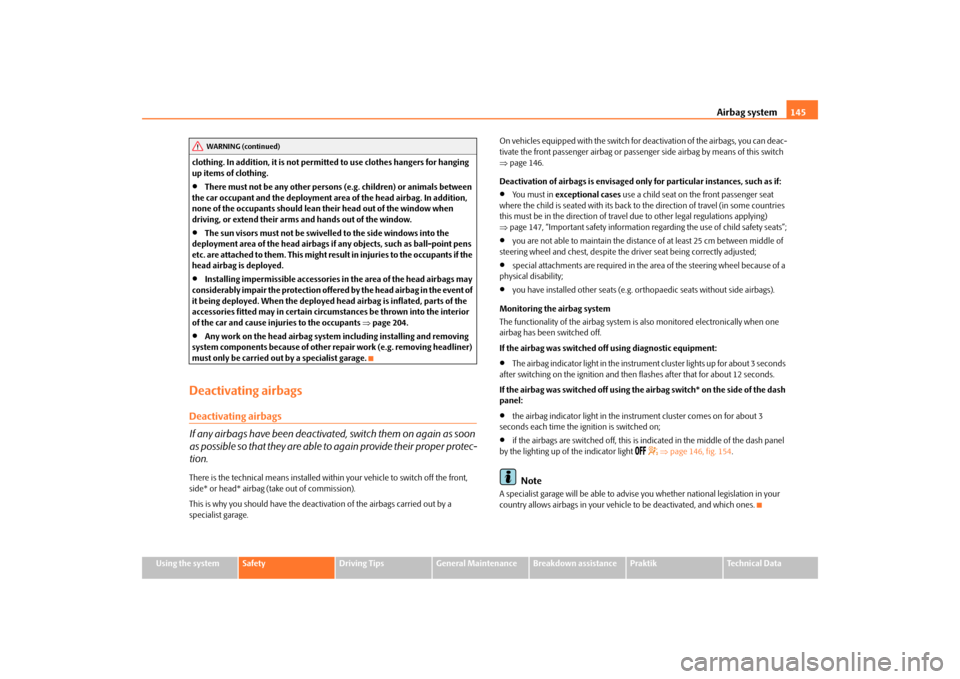
Airbag system145
Using the system
Safety
Driving Tips
General Maintenance
Breakdown assistance
Praktik
Technical Data clothing. In addition, it is not permitted to use clothes hangers for hanging
up items of clothing.
•
There must not be any other persons (e.g. children) or animals between
the car occupant and the deployment area of the head airbag. In addition,
none of the occupants should lean their head out of the window when
driving, or extend their arms and hands out of the window.
•
The sun visors must not be swivelled to the side windows into the
deployment area of the head airbags if any objects, such as ball-point pens
etc. are attached to them. This might result in injuries to the occupants if the
head airbag is deployed.
•
Installing impermissible accessories in the area of the head airbags may
considerably impair the protection offered by the head airbag in the event of
it being deployed. When the deployed head airbag is inflated, parts of the
accessories fitted may in certain circumstances be thrown into the interior
of the car and cause injuries to the occupants ⇒page 204.
•
Any work on the head airbag system including installing and removing
system components because of other repair work (e.g. removing headliner)
must only be carried out by a specialist garage.
Deactivating airbagsDeactivating airbags
If any airbags have been deactivated, switch them on again as soon
as possible so that they are able to again provide their proper protec-
tion.There is the technical means installed within your vehicle to switch off the front,
side* or head* airbag (take out of commission).
This is why you should have the deactivation of the airbags carried out by a
specialist garage.On vehicles equipped with the switch for deactivation of the airbags, you can deac-
tivate the front passenger airbag or passenger side airbag by means of this switch
⇒page 146.
Deactivation of airbags is envisaged only for particular instances, such as if:
•
You must in exceptional cases use a child seat on the front passenger seat
where the child is seated with its back to the direction of travel (in some countries
this must be in the direction of travel due to other legal regulations applying)
⇒page 147, “Important safety information regarding the use of child safety seats”;
•
you are not able to maintain the distance of at least 25 cm between middle of
steering wheel and chest, despite the driver seat being correctly adjusted;
•
special attachments are required in the area of the steering wheel because of a
physical disability;
•
you have installed other seats (e.g. orthopaedic seats without side airbags).
Monitoring the airbag system
The functionality of the airbag system is also monitored electronically when one
airbag has been switched off.
If the airbag was switched off using diagnostic equipment:
•
The airbag indicator light in the instrument cluster lights up for about 3 seconds
after switching on the ignition and then flashes after that for about 12 seconds.
If the airbag was switched off using the airbag switch* on the side of the dash
panel:
•
the airbag indicator light in the instrument cluster comes on for about 3
seconds each time the ignition is switched on;
•
if the airbags are switched off, this is indicated in the middle of the dash panel
by the lighting up of the indicator light
⇒page 146, fig. 154.
Note
A specialist garage will be able to advise you whether national legislation in your
country allows airbags in your vehicle to be deactivated, and which ones.
WARNING (continued)
s29g.4.book Page 145 Wednesday, June 17, 2009 9:54 AM